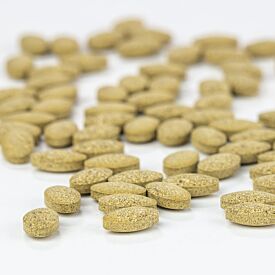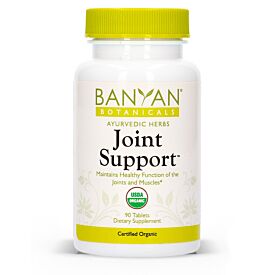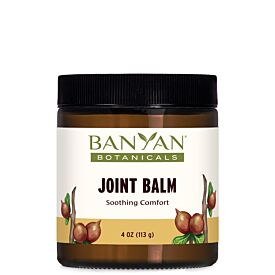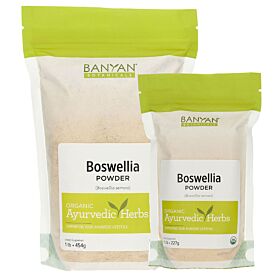The Benefits of Boswellia
Boswellia (Boswellia serrata) is an herbal resin made from the gum of the boswellia tree that holds a place of significance in many religious ceremonies in India and around the world. Also known as Indian frankincense, olibanum, and salai guggul, it has a long history of use in Ayurveda as a rejuvenative herb for supporting joint comfort and mental clarity.1,2
In this article:
- Characteristics of the Boswellia Serrata Tree
- Boswellia Benefits and Uses
- Modern Research on Boswellia
- How to Take Boswellia
- Is Boswellia Safe?
- Growing and Harvesting Boswellia
Characteristics of the Boswellia Tree
The boswellia serrata tree is a moderate-to-large-sized, deciduous member of the Burseraceae family. It has a spreading crown, slightly drooping branches, and leaves with toothed or “serrated” margins (hence the name “serrata”).3
The genus Boswellia contains 28 different species of trees and shrubs, including Boswellia frereana (elemi frankincense), Boswellia papyrifera (elephant tree), and Boswellia sacra (frankincense, olibanum). Along with Boswellia serrata, all four of these varieties are considered commercially important and are frequently referred to as frankincense.4
While other species of boswellia are found throughout the Middle East and Africa, the boswellia serrata tree grows primarily in India, Bangladesh, Pakistan, and Sri Lanka, preferring climates with flat terrain and dry, rocky ridges and slopes.5
Boswellia trees are commonly used for fodder and timber, but are particularly sought after for their thin, peeling bark, which can be tapped to produce the oleo-resin known as frankincense or olibanum.6,7
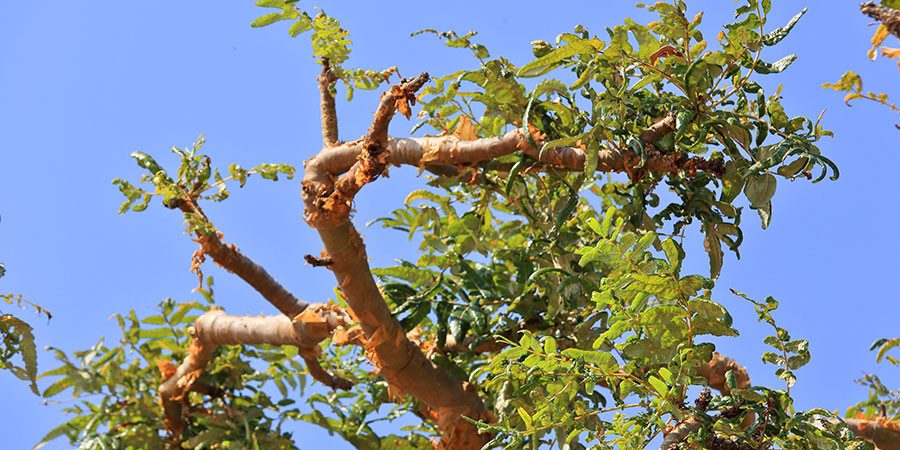
Boswellia Benefits and Uses
Boswellia resin has a long history of use for medicinal, religious, and cosmetic purposes. Along with other frankincense species, boswellia serrata is viewed as an important source of boswellic acid, a naturally occurring constituent of boswellia often used in the pharmaceutical industry.8
From an Ayurvedic perspective, boswellia is considered a rasayana or rejuvenative herb with bitter, pungent, astringent, and sweet tastes (rasa).
In action (virya), it has the dual energetics of being both heating (due to its blood-circulating property) and cooling (due to its ability to whisk away imbalances caused by excess heat). It has a pungent post-digestive effect (vipaka).9
Supportive for all of the dhatus or tissues of the body, boswellia is thought to be balancing for all doshas, though it may aggravate vata and pitta in excess.10
Benefits of Boswellia
- Joint and Bone Health. In Ayurveda, boswellia gum resin is revered for its ability to promote joint comfort and mobility thanks to its soothing, detoxifying effect on the bone tissue (asthi dhatu).
- Detoxification. Boswellia promotes healthy circulation and helps facilitate the removal of ama (natural toxins) in addition to clearing blockages from the channels of the body (srotamsi).11
- Menstrual Comfort. Boswellia’s inherently soothing, cleansing qualities can promote a more comfortable menstrual period, especially to those who experience pitta-type menstrual cycles.12
- Mental Health. Boswellia is thought to open the mind and to have an effect on ajna chakra, the sixth chakra, which is associated with deep knowledge and intuition and has a connection with the pineal gland.13
Modern Research on Boswellia
Several studies have been conducted over the years regarding boswellia and its benefits, including how boswellic acids interact with the body. Here are a few of the most prominent studies on boswellia from recent years:
- “Boswellia serrata: an overall assessment of in vitro, preclinical, pharmacokinetic and clinical data.” PubMed Abstract. Jun 2011.14
- “Antioxidant and Ex Vivo Immune System Regulatory Properties of Boswellia serrata Extracts.” PubMed Abstract. Mar 2017.15
- “In vitro metabolism, permeation, and brain availability of six major boswellic acids from Boswellia serrata gum resins.” PubMed Abstract. Jan 2013.16
- “Boswellia: An evidence-based systematic review by the Natural Standard Research Collaboration.” PubMed Abstract. Feb 2004.17
- “Enhanced absorption of boswellic acids by a micellar solubilized delivery form of Boswellia extract.” Science Direct. Jun 2018.18
How to Take Boswellia
Boswellia is traditionally used both internally and externally. Banyan Botanicals carries boswellia resin powder, which can be prepared as a drink with hot water, or used for a number of external applications.
Taking Boswellia Internally
Boswellia powder. Ayurveda teaches that taste plays an important role in the digestive process, signaling the body to initiate its own supportive mechanisms, so taking boswellia powder internally allows the opportunity to taste the herbal resin for added benefit.
Once or twice a day, add ¼ to ½ teaspoon boswellia to a mug, then add warm water while stirring.
You can also use warm milk or almond milk, depending on your preference. Both can act as powerful anupans or carrier substances for bringing the effects of boswellia deeper into the tissues.
As a resin, boswellia’s texture is heavier and harder to dissolve than herbal powders, and it does have a tendency to clump. Mixing it with hot water and stirring will help soften the resin and make it easier to drink.
Wait a few minutes before drinking to give the heat from the warm water more time to help dissolve the boswellia. The remaining residue will be soft and easy to chew.
For softer boswellia, you can use a coffee bean grinder, blender, or a grinder dedicated to herbs.
Joint Support tablets. Boswellia is also included in Joint Support, an herbal tablet that can be taken once or twice daily to promote healthy joints from the inside out.
Using Boswellia Externally
Boswellia's rich, earthy aroma is just one of the many reasons this resin has been valuable for religious ceremonies throughout the ages.
- To soothe and comfort the muscles and joints, consider using Joint Balm or making a DIY frankincense oil.
- For aromatherapy, consider adding frankincense essential oil to a diffuser or making a DIY frankincense meditation balm.
Is Boswellia Safe?
As a soothing rejuvenative that can bring balance to all three doshas, boswellia is generally considered safe, although its dual heating action could increase vata or pitta in excess.
Contraindications
Boswellia is not recommended for those who are pregnant or nursing. It can also be potentially imbalancing for those with weakened digestion.19
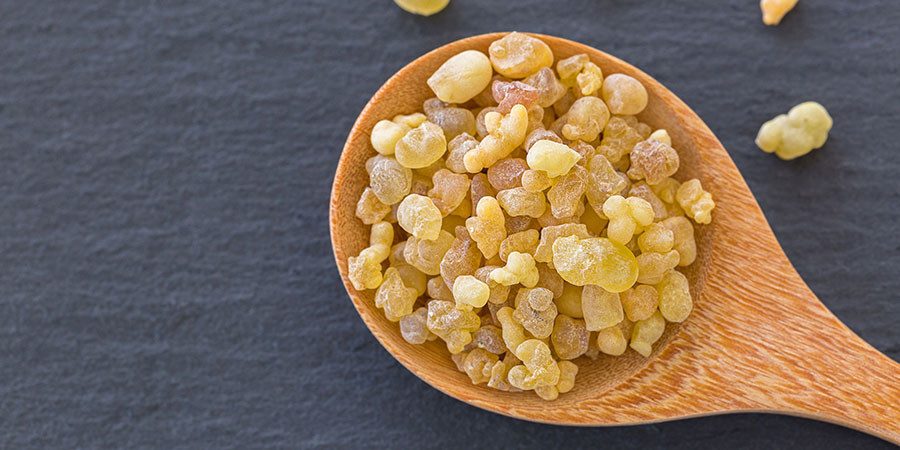
The Growing and Harvesting of Banyan's Boswellia
Banyan’s boswellia grows in India, where it is wild harvested from October to March. We work with locals well-versed with the forest region to identify boswellia trees ready for harvest based on plant maturity and ability to provide resin without overtaxing the trees.
After tapping a tree in one spot and allowing the secretion of resin to continue for a couple days, they collect the accumulated resin and take it to the common collection center for sun-drying.
After it has dried, boswellia resin will generally have impurities like bark and dust, which is then eliminated during hand cleaning.
Traceability of Ayurvedic herbs and botanical ingredients from field to shelf allows the supplier to know where and how the herbs were grown and when they were harvested. Banyan knows exactly where each ingredient was grown and can trace them from your medicine cabinet to the field.
Sustainability
In recent years, there has been growing concern regarding the endangered status of frankincense in the herbal community due to its popularity in herbal formulas and religious ceremonies.20,21
Like all frankincense trees, Boswellia serrata trees are slow-growing, so an investment of time and patience is needed—both for proper forest management and to supply increasing overall yields to keep up with market demands. This is especially true in the case of an oleogum resin like boswellia, which is typically a lower-yielding plant part in general.
While boswellia is not yet endangered by official terms, we could consider it “at-risk” if proper management is not used and awareness raised.
That said, there does seem to be a significant level of involvement from the Indian government regarding the tracking and monitoring of Boswellia serrata. In fact, many boswellia trees seem to be growing on government-owned land, and there are local laws in place regarding how boswellia can be collected.22
As a part of a bigger conversation on the sustainability of Ayurvedic herbs, it is important to understand where and how plants (or in this case, resins) are grown and harvested. Resins can be cultivated and harvested on private farms where sustainability can be managed, or they may be wild harvested in a legal way. When resins are wild harvested illegally, it threatens the long-term sustainability of valuable plants and plant-based products.
This is why we ensure sustainability by sourcing the botanicals used in our products from privately owned farms where each plant has been cultivated, or from legal wild-craft sourcing. Our herbs and ingredient-producing plants are harvested at optimal times, using environmentally sustainable practices that are sensitive to the long-term health of the plants.
Organic Certification
Organic certification is an especially important consideration when choosing which herbs or herbal products to consume. When an herb contains genetic alterations or toxic residues from chemical pesticides, the very substance that was intended to support health and healing can be harmful. Buying organic herbs is the safest way to protect your body from these potentially dangerous toxins.
The boswellia carried by Banyan is USDA certified organic, and is processed in accordance with the USDA's National Organic Program. Banyan is able to ensure that organic farming practices are adhered to because we receive the ingredients from trusted sources whose methods have been verified and monitored. As with all of our products, you can rest assured that boswellia sourced through Banyan Botanicals will be free of pesticides and other harmful chemicals.


